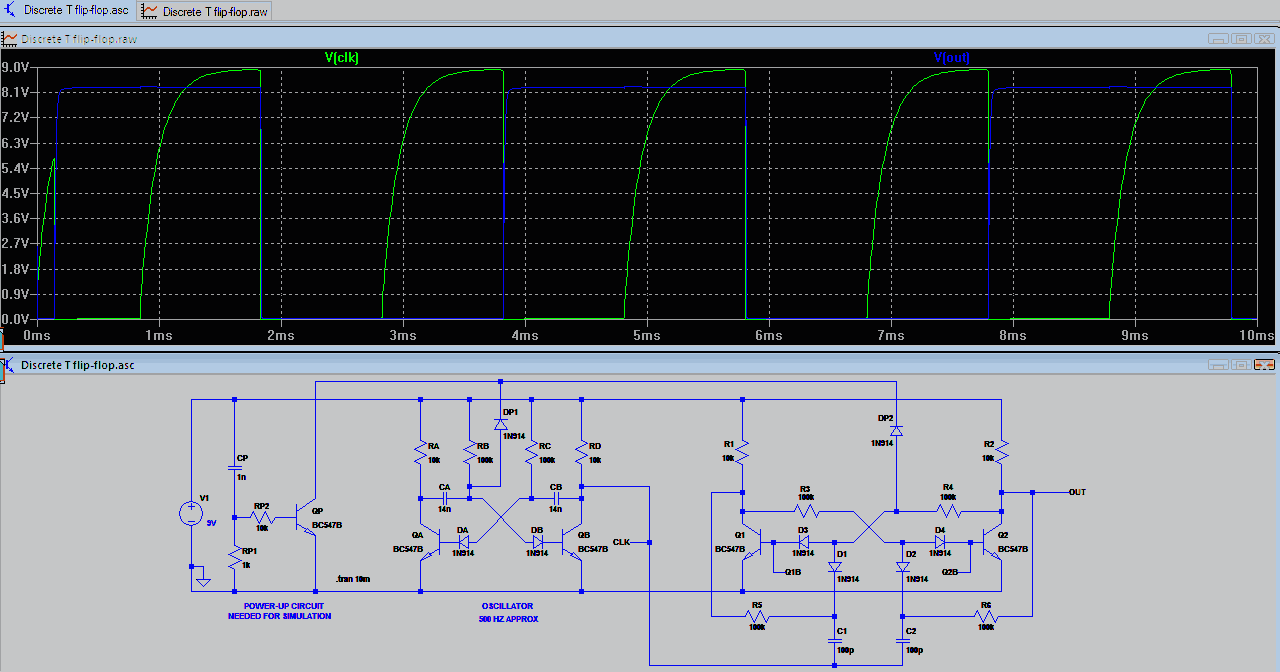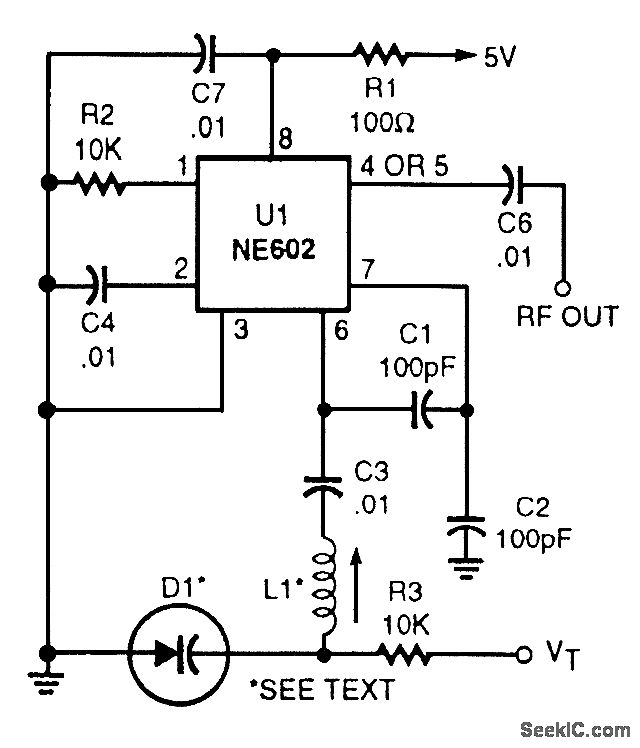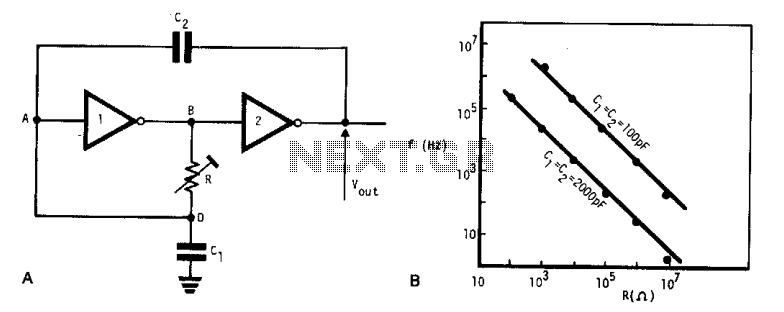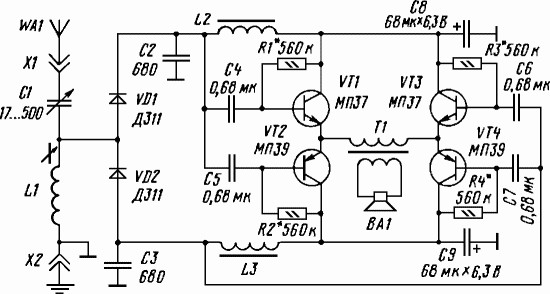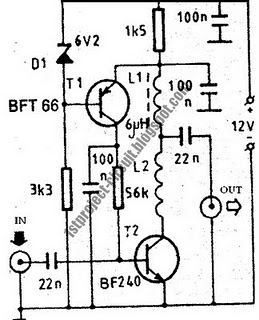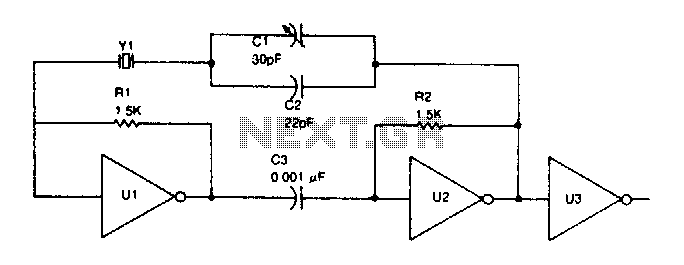
20 MHz VHF CRYSTAL OSCILLATOR
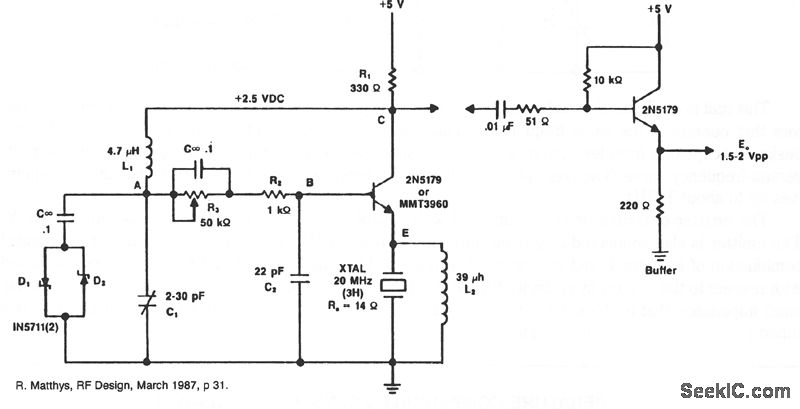
A typical circuit operating at 20 MHz is presented. The crystal, which possesses an internal series resistance (RS) of 14 ohms, oscillates at its third harmonic. Diode clamps D1 and D2 provide constant amplitude control. The transistor functions continuously in a linear mode throughout the entire oscillation cycle, reflecting a reasonably constant load across the crystal at all times.
This circuit operates at a frequency of 20 MHz, utilizing a crystal oscillator that is tuned to its third harmonic. The crystal's internal series resistance (RS) of 14 ohms plays a critical role in determining the quality factor and stability of the oscillation. The harmonic oscillation allows for efficient signal generation, making it suitable for various applications in communication systems.
The inclusion of diode clamps D1 and D2 serves to regulate the amplitude of the oscillations, ensuring that the output signal remains within a defined voltage range. This is particularly important in preventing signal distortion and maintaining the integrity of the waveform during operation. These diodes work by clipping the peaks of the oscillation, thereby providing a form of amplitude stabilization.
The transistor in this circuit is designed to operate in a linear mode, allowing it to amplify the oscillating signal without introducing significant distortion. By maintaining a continuous operation throughout the oscillation cycle, the transistor helps to ensure that the load presented to the crystal remains relatively constant. This consistent load is crucial for sustaining the oscillation and achieving stable frequency output.
Overall, the circuit exemplifies the principles of harmonic oscillation, amplitude control, and linear amplification, making it a robust solution for frequency generation at 20 MHz. The careful selection of components, including the crystal, diodes, and transistor, is essential for optimizing performance and ensuring reliability in practical applications.A typical circuit at 20 MHz is shown. The crystal, which has an internal series resistance RS, of 14 ©, oscillates at its third harmonic. The diode clamp D1 and D2 provides a constant amplitude control. The transistor operates continuously in a linear mode over a complete cycle of oscillation, and reflects a reasonably constant load across the c rystal at an times. 🔗 External reference
This circuit operates at a frequency of 20 MHz, utilizing a crystal oscillator that is tuned to its third harmonic. The crystal's internal series resistance (RS) of 14 ohms plays a critical role in determining the quality factor and stability of the oscillation. The harmonic oscillation allows for efficient signal generation, making it suitable for various applications in communication systems.
The inclusion of diode clamps D1 and D2 serves to regulate the amplitude of the oscillations, ensuring that the output signal remains within a defined voltage range. This is particularly important in preventing signal distortion and maintaining the integrity of the waveform during operation. These diodes work by clipping the peaks of the oscillation, thereby providing a form of amplitude stabilization.
The transistor in this circuit is designed to operate in a linear mode, allowing it to amplify the oscillating signal without introducing significant distortion. By maintaining a continuous operation throughout the oscillation cycle, the transistor helps to ensure that the load presented to the crystal remains relatively constant. This consistent load is crucial for sustaining the oscillation and achieving stable frequency output.
Overall, the circuit exemplifies the principles of harmonic oscillation, amplitude control, and linear amplification, making it a robust solution for frequency generation at 20 MHz. The careful selection of components, including the crystal, diodes, and transistor, is essential for optimizing performance and ensuring reliability in practical applications.A typical circuit at 20 MHz is shown. The crystal, which has an internal series resistance RS, of 14 ©, oscillates at its third harmonic. The diode clamp D1 and D2 provides a constant amplitude control. The transistor operates continuously in a linear mode over a complete cycle of oscillation, and reflects a reasonably constant load across the c rystal at an times. 🔗 External reference
